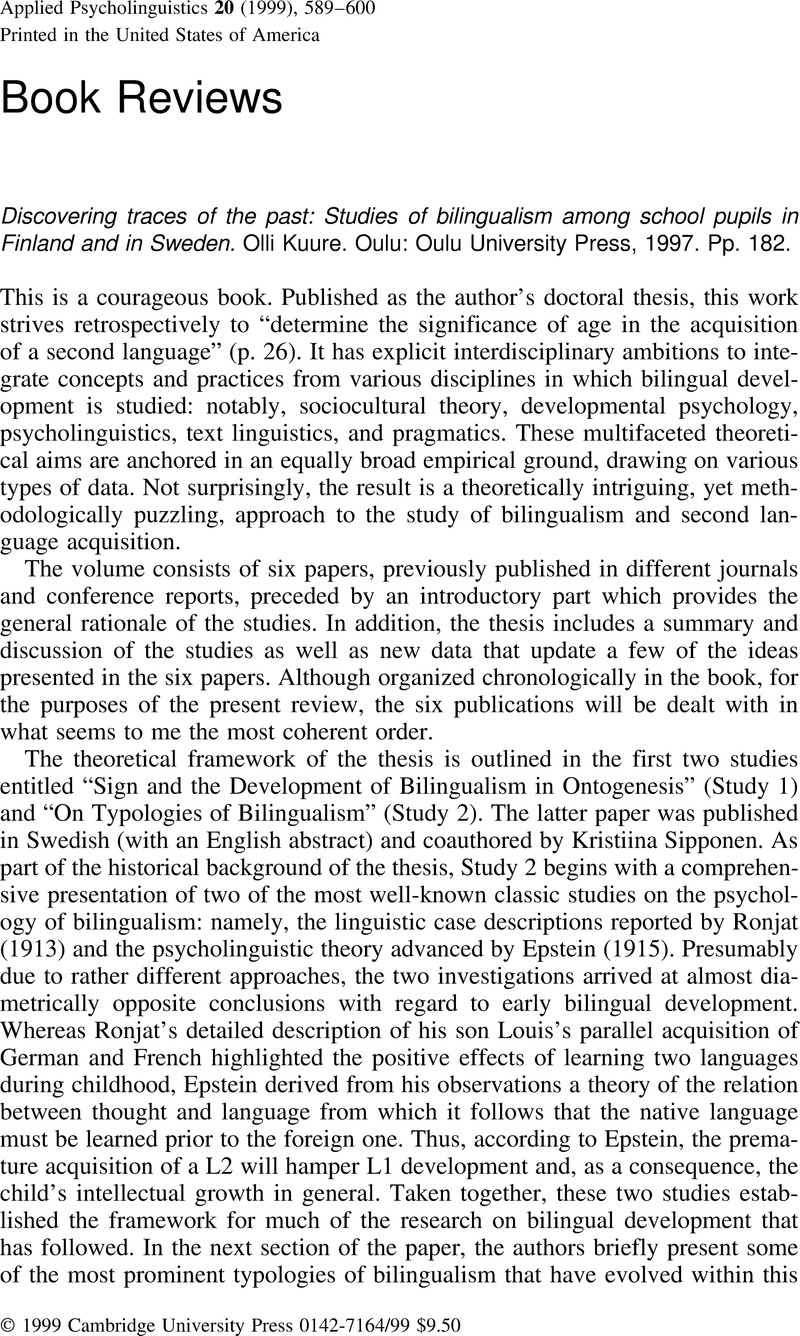No CrossRef data available.
Article contents
Discovering traces of the past: Studies of bilingualism among school pupils in Finland and in Sweden. Olli Kuure. Oulu: Oulu University Press, 1997. Pp. 182.
Published online by Cambridge University Press: 01 December 1999
Abstract
An abstract is not available for this content so a preview has been provided. Please use the Get access link above for information on how to access this content.

- Type
- Book Reviews
- Information
- Copyright
- Copyright © Cambridge University Press 1999
References
Berkowitz, M. W., & Keller, M. (1989). Longitudinal predictors of adolescent academic and social performance. Paper presented at the biennial meeting of the Society for Research in Child Development, Kansas City, MO.Google Scholar
Brown, P., & Levinson, S. (1987). Politeness: Some universal in language use. Cambridge: Cambridge University Press.Google Scholar
Egeland, B., Pianta, R., & Ogawa, J. (1996). Early behavior problems: Pathways to mental disorders in adolescence. Development and Psychopathology, 8, 735–749.Google Scholar
Ervin, S., & Osgood, C. T. (1954). Second language learning and bilingualism. Journal of Personality and Social Psychology, 58, 139–145.Google Scholar
Hamers, J. F., & Blanc, M. H. A. (1989). Bilinguality and bilingualism. Cambridge: Cambridge University Press.Google Scholar
House, J., & Kasper, G. (1981). Politeness markers in English and German. In Coulmas, F. (Ed.), Conversational routine. The Hague: Mouton.Google Scholar
Kasper, G., & Blum-Kulka, S. (1993). Interlanguage pragmatics. Oxford: Oxford University Press.Google Scholar
Lamendella, J. (1977). General principles of neurofunctional organization and their manifestation in primary and nonprimary language acquisition. Language Learning, 27, 155–196.Google Scholar
McLaughlin, B. (1978). Second language acquisition in childhood. New York: Wiley & Sons.Google Scholar
Rodgers, B. (1991). Socio-economic status, employment and neurosis. Social Psychiatry & Psychiatric Epidemiology, 26, 104–114.Google Scholar
Ronjat, J. (1913). Le development du language observé chez un enfant bilingue. Paris: Champion.Google Scholar
Scollon, R., & Scollon, S. B. K. (1994). Intercultural communication: A discourse approach. Oxford: Blackwell.Google Scholar
van der Lucht, F., & Groothoff, J. (1995). Social inequalities and health among children aged 10–11 in the Netherlands: Causes and consequences. Social Science and Medicine, 49, 1305–1311.Google Scholar
Vygotsky, L. S. (1978). Mind in society. The development of higher psychological processes. Cambridge: Cambridge University Press.Google Scholar
Vygotsky, L. S. (1982). Legen och dens rolle i barnets psykologiske udvikling. In Vygotsky, L. S. (Ed.), Om barnets psykologiske utvikling. Copenhagen: Nyt Nordisk Forlag.Google Scholar




